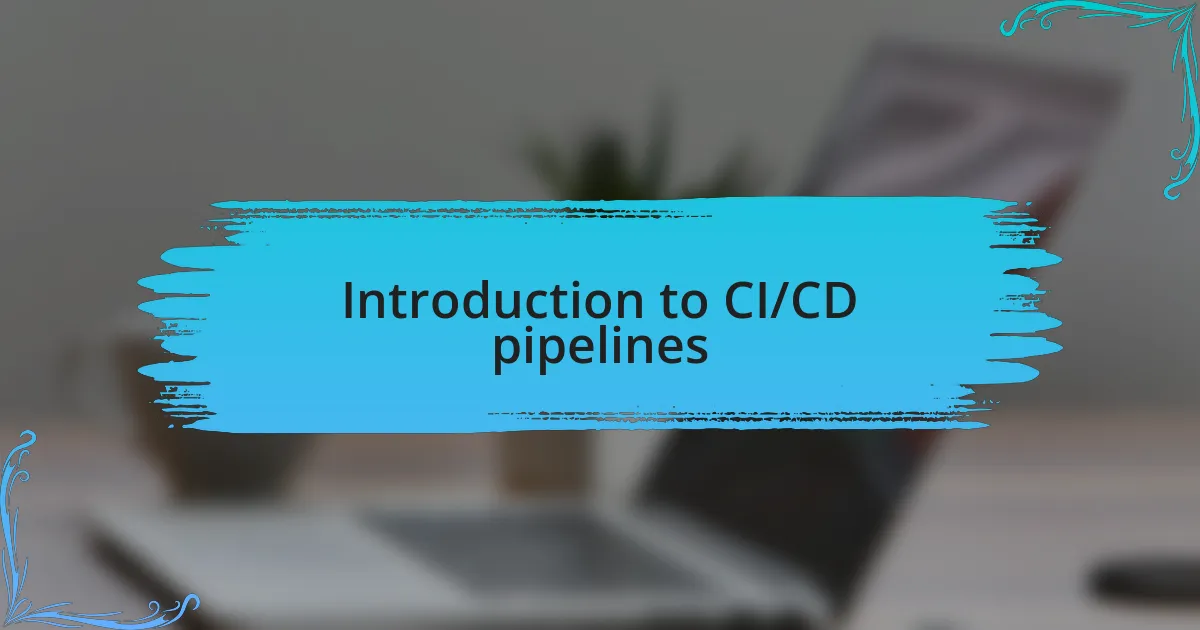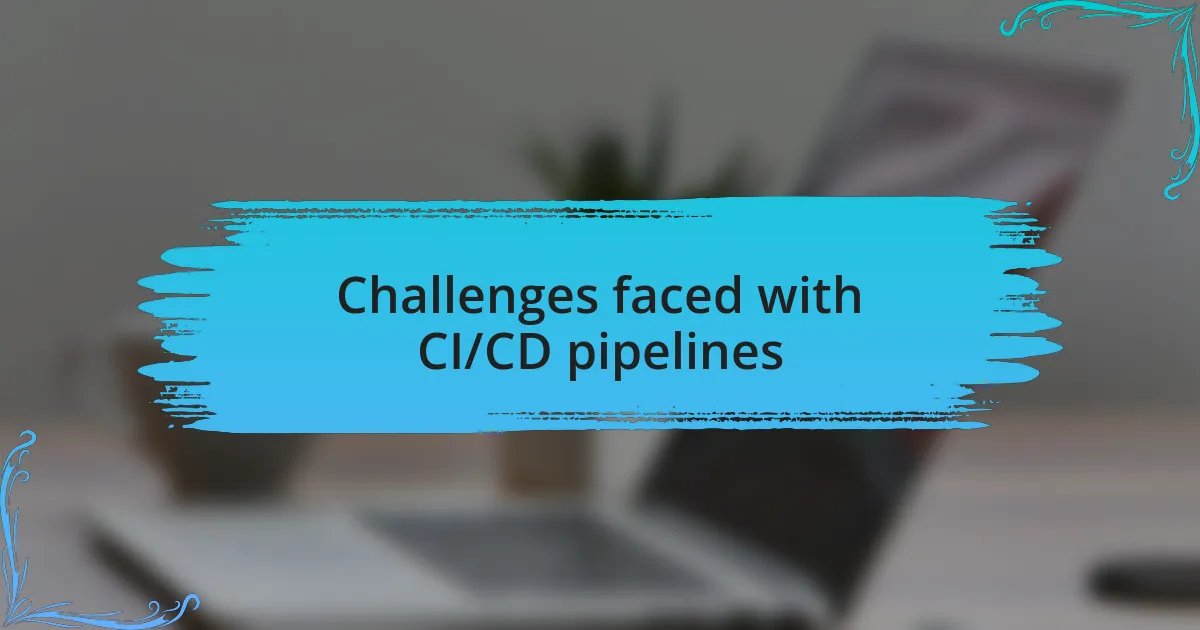Key takeaways:
- CI/CD pipelines enhance efficiency by automating testing and deployment, reducing last-minute bugs and deployment anxieties.
- Collaboration is improved through CI/CD, fostering a cohesive workflow and building trust among team members.
- Key practices for successful CI/CD include understanding workflows, prioritizing automated testing, and establishing regular feedback loops.
- Challenges include integration issues, resistance to cultural changes, and balancing speed with security measures in the pipeline.

Introduction to CI/CD pipelines
CI/CD pipelines represent a transformative approach to software development and deployment, merging Continuous Integration (CI) and Continuous Deployment (CD) into a seamless workflow. I remember the first time I integrated a CI/CD pipeline into a project; it felt like unlocking a new level of efficiency. Suddenly, changes I made could be tested and deployed automatically, which not only saved time but also reduced the anxiety that sometimes accompanies manual deployments.
As I delved deeper into CI/CD, I discovered its core value: the ability to catch bugs early in the development cycle. How many times have we all faced the dreaded scenario of a last-minute bug that surfaces during deployment? With CI/CD, those days became less frequent for me, as automated tests ran with every code change, helping to ensure that my code worked flawlessly before it reached the end user.
Moreover, the collaborative aspect of CI/CD can’t be overlooked. I recall times when my team would joke about the “deployment day jitters,” which often stemmed from uncertainty about what might break. Implementing CI/CD transformed our workflow into a cohesive process where code was consistently reviewed and integrated, fostering a sense of confidence and camaraderie that I had not experienced before. Isn’t it fascinating how a well-structured pipeline can not only enhance productivity but also build trust among team members?

Overview of popular CI/CD tools
When exploring popular CI/CD tools, it’s hard not to mention Jenkins. This open-source automation server allows users to create custom pipelines, enabling continuous integration and continuous delivery with an impressive array of plugins. I remember the first time I configured a Jenkins pipeline; there was a sense of empowerment seeing my code changes immediately reflected in our deployment environment.
Another noteworthy tool is GitLab CI/CD, which provides an all-in-one platform for version control and deployment. I found GitLab’s built-in CI/CD capabilities incredibly user-friendly, making it a breeze to manage projects and automate workflows. Wasn’t it a revelation to realize that I could streamline everything within a single interface? This centralization not only simplified our process but also improved team communication—a significant win for productivity.
Lastly, there’s CircleCI, widely favored for its speed and flexibility. The moment I started using CircleCI, I was struck by how quickly it processed builds compared to other tools I’d tried. This speed, combined with its ability to integrate seamlessly with various version control systems, made it an instant favorite in my toolkit. Have you ever experienced that thrill when a tool just clicks with your workflow? It’s moments like these that reinforce the importance of finding the right CI/CD solution for your team.

Best practices for CI/CD implementation
When implementing CI/CD processes, one of the best practices is to begin with a clear understanding of your workflow. I recall a time when my team felt overwhelmed by the complexities of automation. By mapping out our existing processes first, we uncovered inefficiencies that, once addressed, streamlined our CI/CD pipeline considerably. Have you ever felt lost in technical details? Realizing that clarity forms the backbone of successful implementation made a profound difference for us.
Another crucial element is to prioritize automation in testing. I remember hesitating to automate our tests, fearing that the initial setup might be too time-consuming. However, once we committed to it, we experienced a dramatic reduction in bugs and deployment issues. It’s remarkable how investing time upfront in automated testing can pay off in clean, reliable releases. Isn’t it reassuring to know that streamlined testing can save time in the long run?
Moreover, regular feedback loops are essential. I once worked on a project where we established a feedback mechanism, allowing the team to evaluate deployments immediately after release. The insights we gained were invaluable, leading to constant adjustments and improvements to our pipeline. This openness to feedback quickly became a part of our culture. Have you ever considered how sharing feedback can transform your CI/CD success? Embracing this practice can foster a collaborative environment that continually enhances the development process.

Challenges faced with CI/CD pipelines
Challenges with CI/CD pipelines can be daunting. Early on in my journey, I encountered integration issues that seemed relentless, particularly when trying to combine different tools. I remember one instance where our build system failed continuously due to version discrepancies across development environments. It really made me ponder—how do we ensure that everyone is on the same page? Addressing such integration challenges not only demands time but also calls for consistent communication within the team.
Another hurdle I faced was the cultural shift required to embrace CI/CD fully. In one project, I noticed some team members were resistant to change, clinging to their manual processes. I empathized with their apprehension; I had my own fears about automated deployments. It struck me how important it is to foster a culture that not only welcomes but champions change. Have you ever had to shift your team’s mindset? Ultimately, instilling a sense of ownership and collaboration can make all the difference.
Security also poses unique challenges in CI/CD environments. I recall a particularly tense moment when we had to address a security vulnerability that was flagged during a deployment. It was a wake-up call for us to re-evaluate how we incorporated security practices into our pipeline. This experience left me wondering—how can we proactively integrate security measures without slowing down our process? Balancing speed and security continues to be a tightrope walk for many teams, and it’s vital to find that equilibrium.